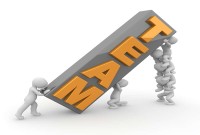- Home
- Business Processes
- Industry Knowledge
- Aerospace Industry
- Automotive Industry
- Banking Domain
- BFSI Industry
- Consumer/ FMCG Industry
- Chemicals Industry
- Engineering & Construction
- Energy Industry
- Education Domain
- Finance Domain
- Hospitality Domain
- Healthcare Industry
- Insurance Domain
- Retail Industry
- Travel and Tourism Domain
- Telecom Industry
- Leadership Skills
- eLearning
- Home
- Leadership
- Leadership Theories
- Definition of Leadership
Definition of Leadership
Leadership has been defined in different ways by different sets of scholars. In very simple terms leadership can be defined as the skill of a person to influence an individual or a group for achievement of a goal in a given situation. One can use different dimensions and perspectives to define leadership. Through the evolution of leadership thought, leadership has been defined in various ways discussed here.
“A leader is one who has followers”; is a too simple a definition and this description does not clearly define what other attributes are associated with leadership. One can use different dimensions and perspectives to define leadership. Through the evolution of leadership thought, leadership has been defined in various ways with following perspectives:
- Group Processes
- Personality Perspective
- Behavioral Traits
- Power Relationships
- Process perspective
- Skills perspective
Definitions of Leadership
According to MacIver and Page Leadership is the capacity to persuade or to direct man that comes from personal qualities apart from office. It indicates the difference between leadership and office. An individual does not become a leader only by occupying an office which carries responsibility. It is a matter of secondary importance that his important office is of assistance to him in his endeavor to become a leader.
According to Philip A. Woods (2005) leadership is not just a set of free-standing actions i.e., it is not a linear process flowing from leader to the follower but it is a collective entity which comprises of the impetus and direction that emerges from the group which is more than the sum of its parts (the individuals) who make up a group or organization. .
Warren Bennis’ definition of leadership is focused much more on the individual capability of the leader. He defined leadership as a function of knowing oneself, having a vision that is well communicated, building trust among colleagues, and taking effective action to realize one’s own leadership potential.
Leadership can also be called the catalyst that transforms potential into reality. The concept of leadership in itself covers all interpersonal relationships that influence the working of' the organization towards achieving its business objectives and growth.
Leadership is the art of influencing others to direct their will, abilities and efforts to the achievement of leader’s goals. In the context of organizations, leadership lies in influencing individual and group effort toward the optimum achievement of organizational objectives.
Keith Davis observes that, “without leadership, an organization is but a muddle of men and machines…Leadership transforms potential into reality. It is the ultimate act which brings to success all the potential that is in an organization and its people”.
Leadership is often defined as the art of influencing others (people) to strive willingly; to do what the leader wants them to do (often to do the mutually compatible objectives) with zeal and confidence.
According to Dayal (1999) leadership is development of people, not the task. A leader creates conditions for the development of individuality and enhancement of inherent capability of individuals.
The leader is the inspiration and director of the action. He is the person in the group that possesses the combination of personality and leadership skills that makes others want to follow his direction.
Leadership focuses on “people” aspect of management and is based on the assumption that organizational effectiveness significantly depends on their motivation, effort and abilities.
According to Pigors, “Leadership is a process of control in which by the assumption of superiority a person or group regulates the activities of others for purposes of his own choosing.”
In 1938, Chester Bernard gave a new definition of leadership and stated that, “leadership is the ability of a superior to influence the behaviour of subordinates and persuade them to follow a particular course of action”.
A recent theorist on leadership, Williams (2005), states that, “leadership is an interactive art in which the leader is dancing with the context, the problem, the faction, and the objective”.
It is encouraging and inspiring individuals and teams to give their best to achieve a desired result.
Leadership is an attribute of the person who is an ideal for the other members of the group.
Leadership is the behavior that affects the behavior of other people, more than their behavior affects that of the leader.
Leaders work with and through people to accomplish goals.
In the 21 Irrefutable Laws of Leadership, John Maxwell sums up his definition of leadership as “leadership is influence - nothing more, nothing less.”
Anyone who acts as a model to others is often called a “leader”.
Leader leads, suggests, orders, and also guides. Other people follow him. We can say that leadership and domination are not the same meaning.
Peter Drucker defined a leader as someone who has followers.
What is the best definition of leadership?
It is difficult to qualitatively define leadership. Leadership involves various dimensions and attributes. A simple definition of leadership is that leadership is the art of motivating a group of people to act towards achieving a common goal. It is a psychological process of providing guidance for followers. To lead is to guide, conduct, direct, and proceed.
Related Links
You May Also Like
-
The ten most important qualities that define a good leader are self-awareness, interpersonal and communication skills, ethical values, organizational consciousness, self-confidence, adaptability and flexibility, imagination and creativity, focus & result-orientation, continuous self-development and accountability and ownership for his actions. These ten qualities of leadership every good leader should possess to a certain extent and must continually strive to develop them.
-
What are the functions which a leader does to establish as a leader? What are the activities undertaken by them to become great leaders, rather revolutionary leaders? The most important tasks done by a leader in all situations are defining the vision, mission, and goals, leading the team, administrative functions, motivating followers, decision making and conflict resolution, and continuous development.
-
There are four characteristics of leadership that help us to understand the character of leadership as a concept. 1. Leadership is a process, 2. Leadership involves influence, 3. Leadership always occurs in a group context and 4. Leadership involves goal attainment. These are the four components that make up the character of the 'leadership' term and help us to define the leadership concept. All of these components of leadership have common characteristics.
-
Frederick Winslow Taylor started the “Scientific Management Movement”, and attempted to study the work process scientifically. Scientific management, also called Taylorism, was a theory of management that analyzed and synthesized workflows. It is a system for increasing the efficiency of manpower to its maximum potential and streamlining production to improve efficiency. This article explores this theory in more detail.
-
There are four major factors in leadership called Leader, Follower, Communication, and Situation. The success of the leader is dependent on how the leader is effectively able to communicate and motivate followers to perform desired tasks using the appropriate leadership style best suited for the given situation. Interdependencies and dynamics of these four factors of leadership must be considered by a leader to be effective.
-
Emergent leadership occurs when a group member is not appointed or elected as leader, but rather that person steps up as the leader over time within-group interactions. Have you ever faced challenges in getting accepted into your new role of position as a leader? Groups don't automatically accept a new "boss" as a leader. Emergent leadership is what you must do when taking over a new group. Learn more about emergent leadership.
-
All the teams are dynamic in nature and they take time to come together, they form, develop, and grow in stages, over a period of time. Teams go through five progressive stages: Forming, Storming, Norming, Performing and Adjourning. In this article, we want to introduce you to these stages of team development and certain strategies that you can use to help the team grow and develop in each of these stages.
-
Team Foundation in Forming Stage
This is the first stage of team development. This is the stage when the foundation of the team is laid. During the Forming stage, team members have a high dependence on their leader for guidance. Learn the practical strategies you can use during this stage to help your team develop into a highly effective performing team.
-
Behavioral Approach to Management
The behavioral management theory had a profound influence on management by focusing on understanding the human dimensions of work. It is also called human relations movement as behavioral theorists focused on managing productivity by understanding factors of worker motivation like their needs and expectations, personality, attitudes, values, group behavior, conflict, and group dynamics. It advocated the use of psychological techniques to motivate employees.
-
The development of teams is an ongoing process because the composition of the team may keep on changing. The new members may join and the old members may leave the team. The team members pass through several stages for the development of the team and there has been a lot of research to identify these stages. In this article, we discuss the common theories of team development.
Explore Our Free Training Articles or
Sign Up to Start With Our eLearning Courses

About Us
Learning
© 2023 TechnoFunc, All Rights Reserved










